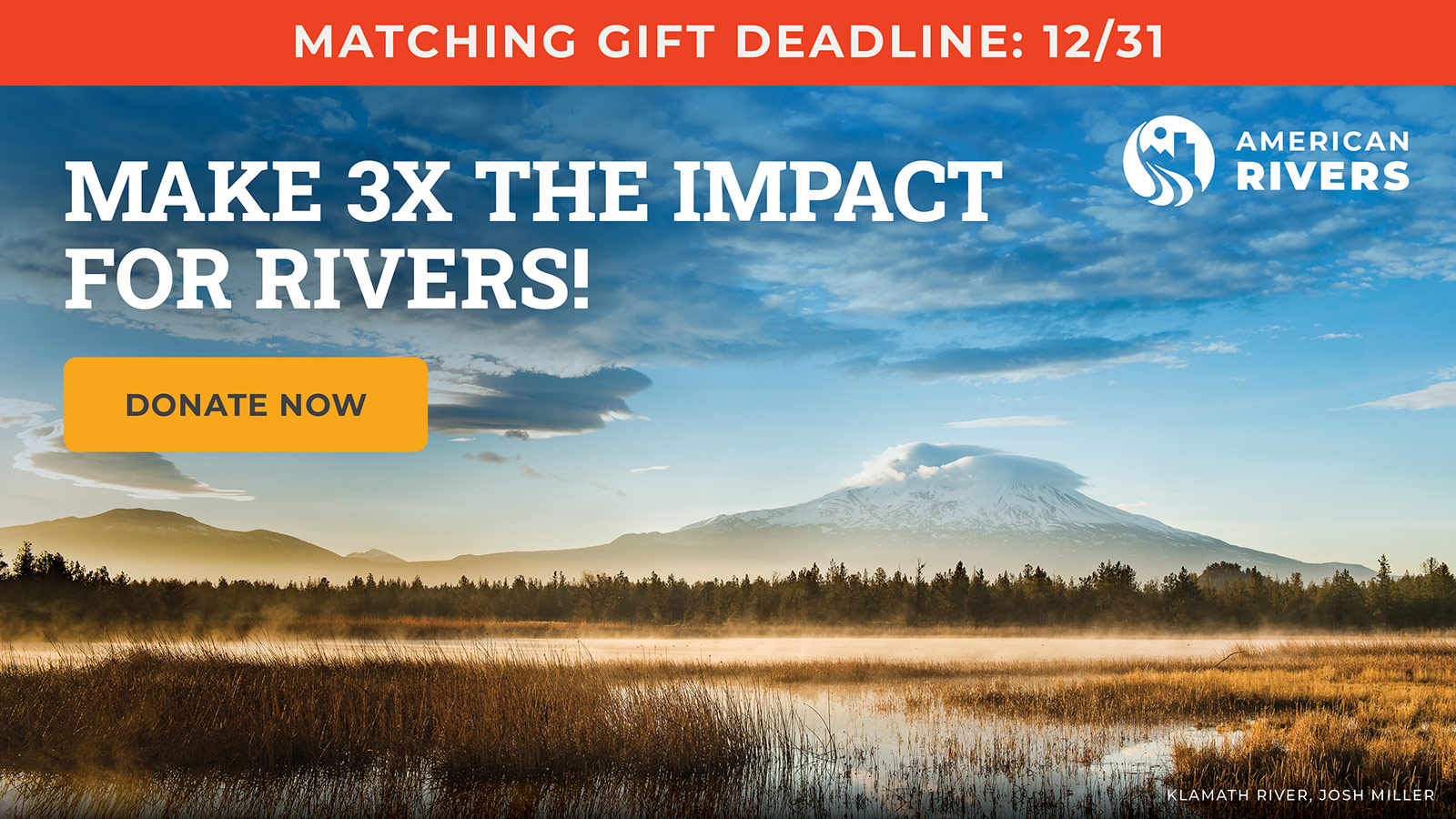Snake River named among America’s Most Endangered Rivers of 2022
Four dams driving salmon to extinction, violating treaties with Northwest tribes
Contact:
Amy Souers Kober, American Rivers, 503-708-1145
Zachary DeWolf, Washington Environmental Council, 206-631-2629
Washington, D.C. – American Rivers today named the Snake River one of America’s Most Endangered Rivers® of 2022, highlighting the threat that four federal dams pose to the future of Tribal Nations and Northwest salmon across the region.
Wild salmon returns plummeted by over 90 percent following the construction of four federal dams – Ice Harbor, Lower Monumental, Little Goose and Lower Granite – on the lower Snake River in eastern Washington state. Today, thirteen salmon and steelhead runs in the Columbia and Snake rivers are listed under the Endangered Species Act. In spring 2021, researchers with the Nez Perce Tribe Department of Fisheries Resource Management predicted that by 2025, 77 percent of wild Chinook populations will be functionally extinct, meaning they have passed a biological threshold of long-term viability. Scientists believe all four salmon and steelhead runs in the Snake River Basin will go extinct without the removal of the four lower Snake dams and restoration of a free-flowing lower Snake River.
“America’s Most Endangered Rivers is an urgent call to action. We have a chance to do something extraordinary here in the Pacific Northwest. We can save salmon from extinction and revitalize the rivers that are the beating heart of this place we call home. We can honor commitments to tribes and invest in a future of abundant salmon, clean energy and thriving agriculture,” said Wendy McDermott, Northwest Regional Director with American Rivers.
American Rivers and its partners called on the Northwest congressional delegation and the Biden administration to work together to pass legislation that restores healthy and harvestable salmon runs, honors commitments to tribes and invests in clean energy and much needed transportation upgrades that will benefit the entire region.
The four lower Snake dams, built between 1955 and 1975, turned 140 miles of cool, free-flowing river into a series of slow-moving reservoirs, leading to lethally high water temperatures for salmon, impeding migration of salmon to and from the Pacific Ocean and killing young salmon attempting to pass through the dams to the ocean. The threat
posed by the dams is exacerbated by climate change, which is warming up the Snake River and making conditions even more dire for salmon. Additionally, the reservoirs are releasing methane into the atmosphere, a greenhouse gas 80 times more potent than carbon dioxide. While the dams are heating up the mainstem of the Snake River below Lewiston, Idaho, climate models project that the thousands of miles of streams above the dams will continue to provide clean, cold water owing to their high elevation and pristine condition. Scientists estimate that by 2080 the Snake River Basin will provide two-thirds of the coldest, most climate-resilient stream habitats for salmon and steelhead on the West Coast.
The dams on the lower Snake River are an ongoing source of injustice for Tribal Nations. The loss of salmon is violating the rights of Tribal Nations ensured by treaty with the U.S. government. The dams and reservoirs submerged or impacted between 600 and 700 important tribal cultural sites along the lower Snake and its tributaries, thousands of acres of treaty-based hunting and gathering places and countless graves of loved ones and sacred and ceremonial places. According to the report, Tribal Circumstances and Impacts of the Lower Snake River Project on the Nez Perce, Yakama, Umatilla, Warm Springs and Shoshone Bannock Tribes, loss of salmon threatens culture, community connection and well-being and is a major factor in health and income disparities.
The annual America’s Most Endangered Rivers report is a list of rivers at a crossroads, where key decisions in the coming months will determine the rivers’ fates. Over the years, the report has helped spur many successes including the removal of outdated dams, the protection of rivers with Wild and Scenic designations and the prevention of harmful development and pollution.
The Snake River was America’s #1 Most Endangered River in 2021. Other rivers in the region listed as most endangered in recent years include the South Fork of the Salmon River (2018-2021), Willamette River (2019) and Smith River (2018).
American Rivers reviews nominations for America’s Most Endangered Rivers from local groups and individuals across the country, and selects rivers based on three criteria: 1) the river’s significance to people and wildlife, 2) the magnitude of the threat to the river and communities, especially in light of climate change and environmental justice, 3) a decision in the next 12 months that the public can influence.
America’s Most Endangered Rivers® of 2022
#1 Colorado River
State: CO, UT, AZ, NV, CA, WY, NM, Mexico
Threat: Climate change, outdated water management
#2 Snake River
State: ID, WA, OR
Threat: Four federal dams
#3 Mobile River
State: AL
Threat: Coal ash contamination
#4 Maine’s Atlantic Salmon Rivers
State: ME
Threat: Dams
#5 Coosa River
State: TN, GA, AL
Threat: Agricultural pollution
#6 Mississippi River
State: MN, WI, IL, IA, MO, KY, TN, AR, MS, LA
Threat: Pollution, habitat loss
#7 Lower Kern River
State: CA
Threat: Excessive water withdrawals
#8 San Pedro River
State: AZ
Threat: Excessive water pumping; loss of Clean Water Act protections
#9 Los Angeles River
State: CA
Threat: Development, pollution
#10 Tar Creek
State: OK
Threat: Pollution
ABOUT AMERICAN RIVERS
American Rivers believes a future of clean water and healthy rivers for everyone, everywhere is essential. Since 1973, we have protected wild rivers, restored damaged rivers and conserved clean water for people and nature. With headquarters in Washington, D.C., and 300,000 supporters, members and volunteers across the country, we are the most trusted and influential river conservation organization in the United States, delivering solutions for a better future. Because life needs rivers. www.AmericanRivers.org


